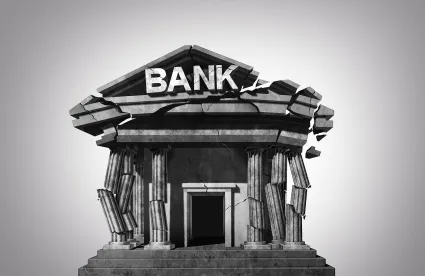A look at recent events in the banking industry, what is new and what is familiar
Recent Events in the Banking Industry
Developments in 2023 surrounding various financial institutions, including failures and a government-led merger, combined with changing macroeconomic conditions, have created uncertainty about the stability and soundness of the banking industry in the U.S. and abroad.
The uncertainty calls to mind prior events involving financial institutions. The 2007–2008 global financial crisis was a period of significant turbulence in financial markets that was followed by multiple bank failures. According to Federal Deposit Insurance Corporation (FDIC) estimates, between 2008 and 2013, nearly 500 banks with combined assets of over $900 billion (in 2022 dollars) failed.1 Decades earlier, during the savings and loan crisis of the 1980s and 1990s, over 1,600 financial institutions with nearly $600 billion in combined assets (in 2022 dollars) failed.2
In contrast, the past decade has seen fewer bank failures. The average number of failed banks per year between 2013 and 2022 was 7.1, a fraction of the 93.0 average number of failed banks per year over the 2008–2012 period. See Figure 1.
Figure 1 Number of Bank Failures Has Declined Since the Global Financial Crisis 2008-2022
Similarly, the number and assets of banks classified by the FDIC as being at greater risk of failure (i.e., “problem banks”)3 have remained below the higher levels seen during the 2008–2014 period.4 See Figure 2.
Figure 2 Number and Assets of “Problem Banks” Have Been Below Historic Levels 2008-2022
Despite the relative stability and soundness of the banking system over the past decade, the recent bank failures and the level of unrealized losses on bank balance sheets raise questions about what may be coming (e.g., additional bank failures, losses on commercial real estate loans, asset fire sales). According to FDIC estimates, as of the end of 4Q 2022, banks held over $620 billion in unrealized losses in their portfolios of available-for-sale and held-to-maturity securities.5 See Figure 3.
Figure 3 Unrealized Losses on Investment Securities Grew in 2022 / 2008-2022
Market valuations of bank stocks have deteriorated since the failure of Silicon Valley Bank and through the beginning of May 2023, suggesting market concerns about what may lie ahead. For example, two indices of stock prices of U.S. regional banks, namely, the KBW Regional Banking Index6 and the Dow Jones U.S. Select Regional Banks Index,7 have declined by 26% and 32%, respectively, relative to their levels on March 8, 2023, just before the Silicon Valley Bank events. Some of the index constituents have declined even more than the indices. For example, Western Alliance Bank and Pacific Western Bank have declined by 57% and 75%, respectively, relative to their closing prices on March 8, 2023, and First Republic Bank stock had declined by 97% over that period, prior to its FDIC-seizure on May 1, 2023. See Figure 4.
Figure 4 Market Values of Regional Banks Have Deteriorated and Remained Depressed 3/1/23-5/2/23
The public press has reported that net inflows into U.S. money market funds increased to more than $340 billion in March 2023, the highest level since the early part of the COVID-19 pandemic in April 2020.8 The rapid movement into money market funds, which may add strain to the banking system, has been attributed to factors including investors seeking higher returns than bank deposits and the view that money market funds may be safer than uninsured bank deposits because funds are invested in highly rated short-term investments.9 These market signals suggest that, in addition to near-term concerns about financial institution failure, there may be questions about the longer-term profitability of the banking sector.
1 Lynn Shibut and George de Verges, “FDIC Resolution Tasks and Approaches: A Comparison of the 1980 to 1994 and 2008 to 2013 Crises,” Federal Deposit Insurance Corporation Staff Studies, 2020, p. 7. Dollar figures converted to 2022 dollars based on CPI data from FRED St. Louis available at https://fred.stlouisfed.org/.
2 Lynn Shibut and George de Verges, “FDIC Resolution Tasks and Approaches: A Comparison of the 1980 to 1994 and 2008 to 2013 Crises,” Federal Deposit Insurance Corporation Staff Studies, 2020, p. 7. Dollar figures converted to 2022 dollars based on CPI data from FRED St. Louis available at https://fred.stlouisfed.org/.
3 “The FDIC identifies ‘problem banks’ as those with examination ratings of 4 or 5—the two lowest ratings, which refer to institutions that exhibit deficiencies in practices or performance so severe that failure is either a distinct possibility (4 rating) or likely (5 rating) unless the deficiencies are corrected.” See “Crisis and Response: An FDIC History, 2008–2013,” Federal Deposit Insurance Corporation, 2017.
4 The sharp rise in assets of “problem banks” in 4Q 2021 “raised eyebrows in the banking and investment community,” and industry participants speculated that a single large financial institution had been added to the “problem bank” list as a result of deterioration due to factors that might include “compliance with the Bank Secrecy Act, or BSA, and anti-money laundering, or AML, policies.” See “Poor Management Rating Likely Placed a Large Bank On FDIC’s ‘Problem Bank’ List,” S&P Global, April 4, 2022, available at https://www.spglobal.com/marketintelligence/en/news-insights/latest-news-headlines/poor-management-rating-likely-placed-a-large-bank-on-fdic-s-problem-bank-list-69475896.
5 See Unrealized Gains (Losses) on Investment Securities, FDIC Quarterly Banking Profile for the Fourth Quarter of 2022, available at https://www.fdic.gov/analysis/quarterly-banking-profile/qbp/2022dec/.
6 According to NASDAQ, the KBW Regional Banking Index seeks to reflect the performance of U.S. companies that do business as regional banks or thrifts. See https://indexes.nasdaqomx.com/Index/Overview/KRX.
7 According to S&P Global, the Dow Jones U.S. Select Regional Banks Index is designed to measure the performance of U.S. companies in the regional banks sector. See https://www.spglobal.com/spdji/en/indices/equity/dow-jones-us-select-regional-banks-index/.
8 “Flood of Cash into US Money Market Funds Could Add to Banking Strains,” Financial Times, March 30, 2023.
9 “People Have Moved Billions from Bank Accounts to Money Market Funds. What Are Those?,” Marketplace, April 5, 2023.




 />i
/>i

